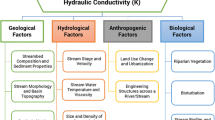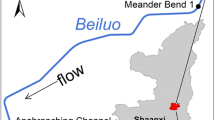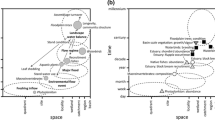Abstract
This paper presents streambed hydraulic conductivities of the Platte River from south-central to eastern Nebraska. The hydraulic conductivities were determined from river channels using permeameter tests. The vertical hydraulic conductivities (K v ) from seven test sites along this river in south-central Nebraska belong to one statistical population. Its mean value is 40.2 m/d. However, the vertical hydraulic conductivities along four transects of the Ashland test site in eastern Nebraska have lower mean values, are statistically different from the K v values in south-central Nebraska, and belong to two different populations with mean values of 20.7 and 9.1 m/d, respectively. Finer sediments carried from the Loup River and Elkhorn River watersheds to the eastern reach of the Platte River lowers the vertical hydraulic conductivity of the streambed. Correlation coefficients between water depth and K v values along a test transect indicates a positive correlation – a larger K v usually occurs in the part of channel with deeper water. Experimental variograms derived from the vertical hydraulic conductivities for several transects across the channels of the Platte River show periodicity of spatial correlation, which likely result from periodic variation of water depth across the channels. The sandy to gravelly streambed contains very local silt and clay layers; spatially continuous low-permeability streambed was not observed in the river channels. The horizontal hydraulic conductivities were larger than the vertical hydraulic conductivities for the same test locations.











Similar content being viewed by others
References
Bentall R (1971) Water supplies and the land – the Elkhorn River basin of Nebraska, Conservation and Survey Division Resource Atlas No. 1, University of Nebraska-Lincoln, 51 p
Conover WJ (1980) Practical Nonparametric Statistics, 2nd edn. John Wiley& Sons, New York, p 493
Chen XH (2000) Measurement of streambed hydraulic conductivity and its anisotropy. Environmental Geology 39(12): 1317–1324
Chen XH, Chen X (2003) Sensitivity analysis and determination of streambed leakance and aquifer hydraulic properties. Journal of Hydrology (284): 270–284
Chen XH (2004) Streambed hydraulic conductivity for rivers in south-central Nebraska. Journal of the American Water Resource Association 40(3): 561–574
Gilbert RO (1987) Statistical Methods for Environmental Pollution Monitoring, Van Nostrand Reinhold, New York, p 320
Hutson SS, Barber NL, Kenny JF, Linsey KS, Lumia DS, Maupin MA (2004) Estimated Use of Water in the United States in 2000. U. S. Geological Survey Circular 1268, 46 p
Hvorslev MJ (1951) Time lag and soil permeability in ground water observations. Waterways Experiment Station, Corps of Engineers, U. S. Army Bulletin 36, Vicksburg, Mississippi, p 50
Kitanidis PK (1997) Introduction to Geostatistics, Applications in Hydrogeology, Cambridge University Press, p 249
Landon MK, Rus DL, Harvey FE (2001) Comparison of instream methods for measuring hydraulic conductivity in sandy streambeds. Ground Water 39(6): 870–885
Nguyen QM, Gilliland MW (1985) Soil, surface water, and groundwater characteristics of the Platte River and its aquifer in the vicinity of Grand Island’s Platte River well field. Report prepared by Department of Civil Engineering, University of Nebraska-Lincoln Omaha Campus
Olea RA (1999) Geostatistics for Engineers and Earth Scientists. Kluwer Academic Publishers, Boston
Rus DL, McGuire VL, Zurbuchen BR, Zlotnik V (2001) Vertical profiles of streambed hydraulic conductivity determined using slug tests in central and western Nebraska. U. S. Geological Survey Water-resources Investigation Report 01–4212, 32 p
SAS Institute (2001) SAS/STAT, Version 8, 1999–2001, SAS Institute Inc., Cary, NC, USA
Webster R (1977) Spectral analysis of gilgai soil. Australian Journal of Soil Research 15, 191–204
Webster R, Oliver M (2000) Geostatistics for Environmental Scientists, John Wiley& Sons, LTD, New York, 271 p
Acknowledgments
This work was partially supported by a U. S. Geological Survey grant (104b) through the Water Center of the University of Nebraska-Lincoln. Jerry Leach, Yanfeng Yin, and Fujiang Wen assisted permeameter tests on the Platte River. Dee Ebbeka and Ann Mack drafted several figures. Charlie Flowerday provided editorial reviews. This paper is assigned Journal Series Number 14922, Agricultural Research Division, University of Nebraska-Lincoln.
Author information
Authors and Affiliations
Corresponding author
Rights and permissions
About this article
Cite this article
Chen, X. Statistical and geostatistical features of streambed hydraulic conductivities in the Platte River, Nebraska. Environ Geol 48, 693–701 (2005). https://doi.org/10.1007/s00254-005-0007-1
Received:
Accepted:
Published:
Issue Date:
DOI: https://doi.org/10.1007/s00254-005-0007-1




